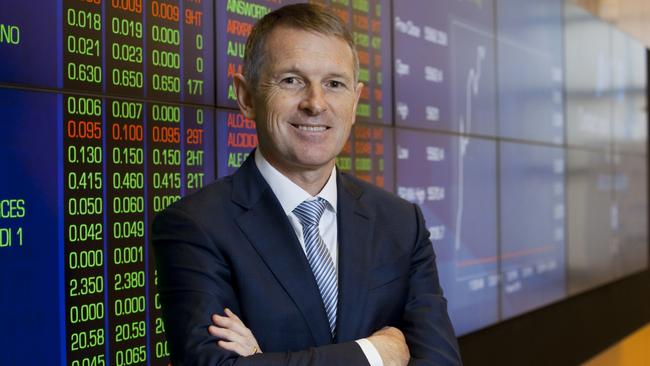Record trading volumes, surge in capital raisings boost ASX profit amid COVID-19 pandemic
A surge in trading volumes and capital raisings pushed the ASX to its highest annual earnings per share on record.

The ASX is expecting to see continued sharemarket volatility, more capital raisings and some pick-up in new listings over the next few months, according to chief executive Dominic Stevens.
“We are going to have an interesting market over the next six months, with a US election and the question is whether there will be a vaccine against COVID-19 or not,” he said in an interview with The Australian.
“Over the next six months there will be some volatility and volume in equity markets.”
Mr Stevens was speaking after the ASX reported what it described as a “robust” 4.4 per cent increase in underlying net profit to $513.8m for the year to the end of June, on the back of record trading activity and volatility as a result of COVID-19 pandemic.
Shares in the group closed at a record high following the result, which came alongside an 8.6 per cent increase in revenues over the year to $938.4m.
But higher costs as a result of the pandemic helped to push expenses up by 9 per cent over the year, to $286.2m.
The pandemic saw a strong increase in cash market trading and a near record of secondary capital raisings as companies moved to shore up their balance sheets.
This was partially offset by a slowdown in trading in the derivative markets in the first six months of 2020 and a reduction in new listings.
“The strong performance of our core businesses generated solid underlying profit growth, while the investment in the resilience of our systems helped ensure the availability of ASX’s markets throughout the COVID-19 pandemic,” Mr Stevens said.
Each of the ASX’s four main businesses grew, with overall performance supported by higher cash market trading and a growth in appetite for technical connections and information services.
“Given the turmoil of the final quarter, the increase reflects the strength of the ASX listed capital markets, including the responsiveness of our rules,” he said.
“Price discovery remained strong and companies were able to raise capital promptly and efficiently.
“There was a big spike in trading in the March period,” Mr Stevens said.
“We were able to work through in an expeditious way to help companies raise capital in what was a very stressful time. It was good to see the wheels of the capital markets turning.”
He said the local market was quicker to react than most others, with a significant amount of new capital raisings since March.
More than $30bn in secondary capital was raised in the June quarter, the second largest in ASX history after the December quarter of 2009.
The daily average cash value of on-market trading was up 29 per cent over the year, to $6bn, while new and second capital raisings were up 13 per cent to $97.2bn.
Mr Stevens said the market had now “got back to more normal trading conditions”.
The outlook for more secondary capital raisings was “expected to remain buoyant”, with more new capital raisings being announced during results season.
The number of new listings over the year was down 25 per cent to 83.
Mr Stevens said there had been a “strong pipeline” of IPOs just before COVID-19 stuck which had all but stopped with the onset of the pandemic.
But he said “people are starting to talk about IPOs again. They are out on the hustings, talking to people about the possibilities over the next 12 months.
“It’s not a demand issue, it’s a confidence issue.
“Someone needs to take a step out there and go and once people get their confidence up, there will be a flurry of them.”
Mr Stevens said the ASX was a less volatile company than many others because of its diversified revenue streams.
It had managed to cope with having most of its staff — some 700 — shift to working from home at a time, as a result of COVID-19, when the sharemarket had its biggest fall since the crash of October 1987.
“It was a bit scary that day when everyone had to do it (work from home) at the same time,” he said. “It was a testament to the amount of work we have done on resilience and risk management, particularly around staff mobility.”
ASX has offices in Sydney, Melbourne and Perth but it only has around 20 people working in Melbourne.
Mr Stevens said people had begun coming back to work, with about 150 working from the office — a trend which has slowed in the wake of concern over the situation in Melbourne.
The ASX was working towards a switch to a blockchain-based system to replace its CHESS system, from April 2022. The start of the new system had been delayed by just over a year because of the pandemic.
Mr Stevens said most of the software for the new system was now available to participants who could begin trialling it and developing new products based on the technology.
The ASX All Ordinaries index was down over the year from 6,699.2 points at the end of June 2019, to 6,001.1 at end June 2020.
The company’s statutory profit was up by 1.4 per cent to $498.6m. It has announced an increase in its final dividend of 7.2 per cent, to 122.5c per share fully franked, bringing its total annual dividend to 238.9c per share, up 4.5 per cent.
Mr Stevens said the year saw the launch of the S&P/ASX All Technology Index “in recognition of the growth and importance of technology listings” in the market, with technology being the best performing sector during the pandemic.
The result follows capital spending of just over $80m during the year to increase the ASX’s technological capabilities, with plans to increase this to $90m- $95m this year as it prepares for the CHESS replacement.
ASX shares rose by $2.39, or 2.73 per cent, in Thursday’s trading to close at a record $89.91.




To join the conversation, please log in. Don't have an account? Register
Join the conversation, you are commenting as Logout